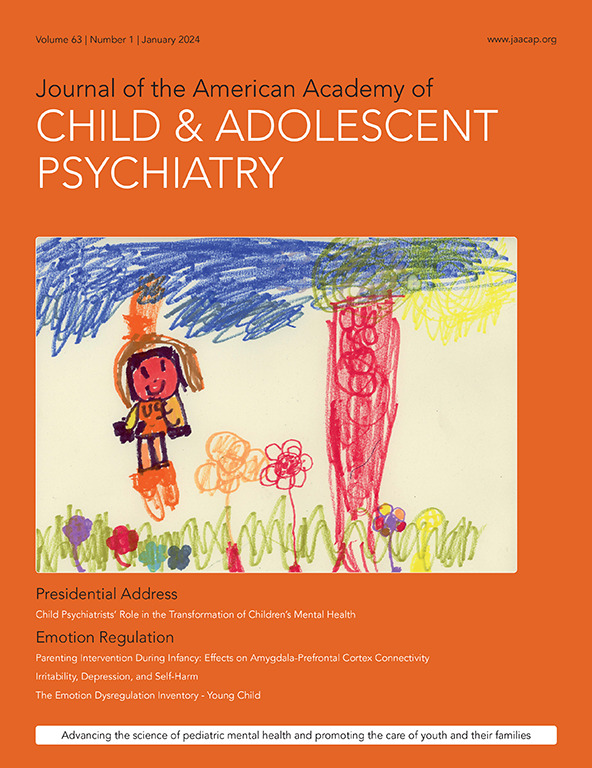种族-民族歧视与青少年早期行为问题:父母温暖的保护作用》。
IF 9.2
1区 医学
Q1 PEDIATRICS
Journal of the American Academy of Child and Adolescent Psychiatry
Pub Date : 2025-02-01
DOI:10.1016/j.jaac.2024.03.020
引用次数: 0
摘要
研究目的本研究旨在调查多种来源(即教师、学生和其他成年人)的歧视与早期青少年行为问题(即内化、外化和注意力问题)之间的关联,同时考虑父母的温暖在这种关联中的保护作用:我们对青少年大脑认知发展(ABCD)研究(Adolescent Brain Cognitive Development (ABCD) Study)一年级随访(Y1)中的 3,245 名有色人种青少年进行了横断面分析,这是一个大型、多元化的美国儿童样本(N = 11,876 人,Mage = 9.48 岁)。少数种族青少年报告了歧视来源、父母温暖程度和心理病症状。为了研究少数种族青少年中歧视来源、父母温暖和行为问题之间的关联,我们进行了带交互项的回归分析。我们还进行了敏感性分析,以研究:(1)种族/族裔和性别差异;(2)不同歧视来源与行为问题之间的关联是否存在可靠的差异;(3)歧视、父母的温暖以及它们在第一年对青少年第二年行为问题的预测作用:结果:早期青少年在人际交往中受到来自教师、学生和其他成年人等多方面的种族-民族歧视,他们的注意力、内化和外化问题水平较高。父母的温暖对人际种族-民族歧视与早期青少年行为问题之间的关联具有保护作用:结论:遭受来自教师、同伴和其他成年人的人际种族-民族歧视与种族-民族青少年的注意力、内化和外化问题的增加有关。父母的温暖可能会降低在校外遭受来自学生、教师和其他成年人的人际种族-民族歧视的青少年出现行为问题的风险。本文章由计算机程序翻译,如有差异,请以英文原文为准。
Racial–Ethnic Discrimination and Early Adolescents’ Behavioral Problems: The Protective Role of Parental Warmth
Objective
The purpose of the study was to investigate the association between discrimination by multiple sources (ie, teachers, students, and other adults) and early adolescents’ behavioral problems (ie, internalizing, externalizing, and attention problems), also considering the protective role of parental warmth in the association.
Method
Cross-sectional analyses were conducted with 3,245 early adolescents of color obtained from the Adolescent Brain Cognitive Development Study (ABCD Study) at year 1 follow-up (Y1), a large and diverse sample of children (mean age = 9.48 years) in the United States. Racially–ethnically minoritized adolescents reported sources of discrimination, parental warmth, and symptoms of psychopathology. Regression with interaction terms was conducted to investigate the associations among sources of discrimination, parental warmth, and behavioral problems among racially–ethnically minority adolescents. Sensitivity analyses were conducted to examine (1) race/ethnicity and sex/gender variations; (2) whether the associations between different sources of discrimination and behavioral problems were reliably different; and (3) effects of discrimination, parental warmth, and their interplay at Y1 in predicting adolescents’ behavioral problems at year 2 follow-up.
Results
Early adolescents experiencing interpersonal racial–ethnic discrimination by multiple sources, including teachers, students, and other adults, reported higher levels of attention, internalizing, and externalizing problems. Parental warmth was protective for the association between interpersonal racial–ethnic discrimination and early adolescents’ behavioral problems.
Conclusion
Experiencing interpersonal racial–ethnic discrimination from teachers, peers, and other adults is related to heightened attention, internalizing, and externalizing problems among racially–ethnically minoritized early adolescents. Parental warmth may reduce the risk of developing behavioral problems among early adolescents who experience interpersonal racial–ethnic discrimination from students, teachers, and other adults outside of school.
Plain language summary
In this cross sectional analysis of 3,245 early adolescents of color obtained from the Adolescent Brain Cognitive Development (ABCD) Study, the authors found that early adolescents experiencing interpersonal racial-ethnic discrimination from multiple sources, including teachers, students, and other adults, reported higher levels of behavioral problems (ie, internalizing, externalizing, and attention problems). Parental warmth was found to be protective for the association between interpersonal racial-ethnic discrimination and early adolescents’ behavioral problems. These findings emphasize the importance of assessing experiences of interpersonal racial-ethnic discrimination among racially-ethnically minoritized early adolescents and contribute to the understanding of parental warmth as a protective factor for early adolescents to cope with such experiences.
Diversity & Inclusion Statement
We worked to ensure race, ethnic, and/or other types of diversity in the recruitment of human participants. We worked to ensure sex and gender balance in the recruitment of human participants. We worked to ensure that the study questionnaires were prepared in an inclusive way. One or more of the authors of this paper self-identifies as a member of one or more historically underrepresented racial and/or ethnic groups in science. One or more of the authors of this paper self-identifies as a member of one or more historically underrepresented sexual and/or gender groups in science. One or more of the authors of this paper received support from a program designed to increase minority representation in science. We actively worked to promote inclusion of historically underrepresented racial and/or ethnic groups in science in our author group. While citing references scientifically relevant for this work, we also actively worked to promote inclusion of historically underrepresented racial and/or ethnic groups in science in our reference list. We actively worked to promote sex and gender balance in our author group. While citing references scientifically relevant for this work, we also actively worked to promote sex and gender balance in our reference list.
求助全文
通过发布文献求助,成功后即可免费获取论文全文。
去求助
来源期刊
CiteScore
21.00
自引率
1.50%
发文量
1383
审稿时长
53 days
期刊介绍:
The Journal of the American Academy of Child & Adolescent Psychiatry (JAACAP) is dedicated to advancing the field of child and adolescent psychiatry through the publication of original research and papers of theoretical, scientific, and clinical significance. Our primary focus is on the mental health of children, adolescents, and families.
We welcome unpublished manuscripts that explore various perspectives, ranging from genetic, epidemiological, neurobiological, and psychopathological research, to cognitive, behavioral, psychodynamic, and other psychotherapeutic investigations. We also encourage submissions that delve into parent-child, interpersonal, and family research, as well as clinical and empirical studies conducted in inpatient, outpatient, consultation-liaison, and school-based settings.
In addition to publishing research, we aim to promote the well-being of children and families by featuring scholarly papers on topics such as health policy, legislation, advocacy, culture, society, and service provision in relation to mental health.
At JAACAP, we strive to foster collaboration and dialogue among researchers, clinicians, and policy-makers in order to enhance our understanding and approach to child and adolescent mental health.

 求助内容:
求助内容: 应助结果提醒方式:
应助结果提醒方式:


